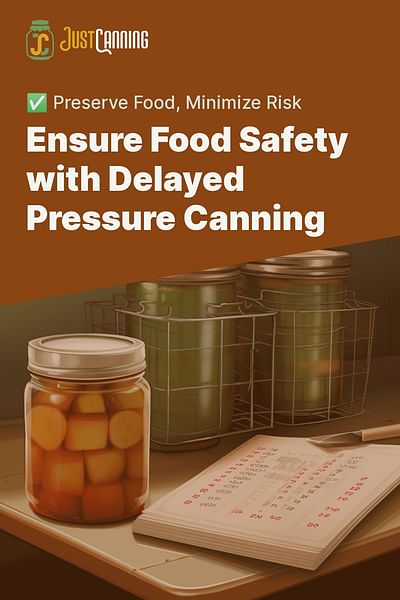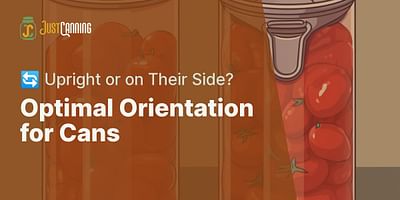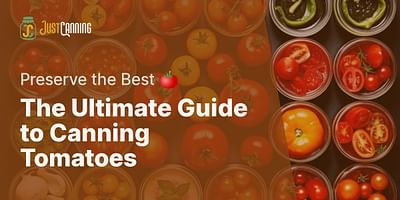Paul Sullivan is a mechanical engineer who has a fascination with canning machines. He enjoys writing about the technical aspects of canning and loves to demystify the process for beginners.
When it comes to pressure canning safety, there are several factors to consider if you're thinking of re-canning food that was canned several weeks ago. The type of food, its storage conditions, and the time elapsed since the initial canning all play significant roles.
For instance, the acidity of the food is a crucial factor. High-acid foods like fruits are less likely to harbor harmful bacteria, making them safer for re-canning. On the other hand, low-acid foods like vegetables and meats require higher temperatures for safe canning, which might not be achieved during re-canning. For more information on specific foods, check out our guides on canning plums or the best tomatoes for canning.
How was the food stored after the initial canning? Proper storage is paramount for re-canning safety. Ideally, canned food should be kept in a cool, dark place, and the jars should show no signs of spoilage. For more detailed information on safe storage, you might want to read our guide on how to safely can corn for long-term storage.
Lastly, the time since the initial canning is a determinant of safety. The longer the food has been canned, the higher the risk of spoilage, especially for low-acid foods.
So, is it safe to re-can food weeks after initial canning? It depends, but always remember, when in doubt, it's better to be safe and discard the food.
Unveiling the Key Factors That Impact Your Re-canning Safety 🥫
Let's delve into some of the key factors that can impact the safety of re-canning food. First off, the acidity of the food plays a significant role. High-acid foods like fruits and pickles are generally safer to re-can as they're less likely to harbor harmful bacteria. On the other hand, low-acid foods like meat and vegetables require higher temperatures during the canning process to ensure safety. To understand more about the canning process, check out our article on how the process of canning functions.
Next, consider how the food was stored after the initial canning. Proper storage is crucial to maintain the quality and safety of canned food. Ideally, jars should be stored in a cool, dark place and show no signs of spoilage such as bulging lids or leakage. For more information on food preservation, you may want to read this article on essential camping food preservation techniques.
Lastly, the time that has passed since the initial canning is a critical factor. The longer the time, the higher the risk of spoilage. This is especially true for low-acid foods. So, if several weeks have passed since the initial canning, you might want to think twice before re-canning. For more details on the safety of canned foods, you can read this comprehensive guide on the health myths and facts of canned foods.
Remember, pressure canning safety is paramount. When it comes to canning food preservation, it's always better to err on the side of caution. If you're unsure, it's best to discard the food and start fresh with one of our tried and tested canning recipes.
How Acidity Levels Play a Pivotal Role in Your Canning Journey 🍋
Understanding the role of acidity in canning is crucial for ensuring pressure canning safety. The acidity of your food can significantly affect the growth of harmful bacteria. High-acid foods like fruits, pickles, or tomatoes naturally create an environment that's less hospitable to bacteria. Therefore, they can be safely processed using a boiling water bath method or a steam canner.
On the other hand, low-acid foods such as vegetables, meats, and poultry require a more aggressive approach. These foods need to be processed at higher temperatures, achievable only through pressure canning. This is because low-acid foods provide a conducive environment for Clostridium botulinum, the bacteria that cause botulism, to thrive. For example, if you're considering canning turkey, you'll need to use pressure canning to ensure safety.
So, if you're considering re-canning food weeks after the initial canning, remember that the acidity of the food plays a significant role in determining its safety. If you've canned low-acid foods, you'll need to be particularly cautious. Always refer to reliable canning recipes and follow the instructions, whether you're using a canning machine or a steam canner. And if you're new to this, a detailed steam canning guide can be your best friend in ensuring safety and success.
Why Proper Storage Matters in the Re-canning Process 🌡️
When it comes to the safety of re-canning food, storage conditions play a pivotal role. After the initial canning, the food should have been kept in a cool, dark place. This is because light and heat can degrade the quality of canned food, potentially leading to spoilage. The jars should also be free of any signs of spoilage such as mold, unusual smells, or discoloration. These could indicate the presence of harmful bacteria or toxins. If you're unsure about the safety of your canned food, you can refer to this FAQ on food safety in canning.
Remember, the goal of canning food preservation is to create a seal that prevents bacteria from entering the jar. However, improper storage can compromise this seal, making it unsafe to consume the food, let alone re-can it. So, before you start following your canning recipes or setting up your canning steamer, inspect your jars carefully. If you're unsure, it's always better to err on the side of caution and discard the food.
Finally, don't forget to refer to a reliable steam canning guide or steam canner instructions. These resources will provide you with the necessary information on how to steam can safely and effectively, including the correct steam canning times.
The Clock is Ticking: Understanding the Impact of Time on Re-canning ⏰
Time is of the essence when it comes to canning food preservation, and this is especially true if you're considering re-canning. The longer the time that has passed since the initial canning, the higher the risk of spoilage. This is particularly important for low-acid foods, which are more susceptible to bacteria growth.
Why is this the case? Well, even when preserved, food continues to break down over time. This can lead to changes in texture, flavor, and most importantly, safety. The longer the food sits, the more opportunities there are for harmful bacteria to develop, especially if the storage conditions are less than ideal.
So, if you're thinking about pressure canning that jar of beans you canned a few weeks ago, you might want to reconsider. The risk simply may not be worth it. Instead, why not try out some new canning recipes? Or perhaps delve into the world of steam canning, using your canning steamer to preserve fresh produce. Remember, when it comes to canning, safety should always be your top priority.
Mastering the Art of Re-canning: Best Practices You Should Follow 🏆
As we've explored, the safety of re-canning food is not a simple yes or no answer. It's a delicate dance involving the food’s acidity, the conditions it was stored in, and the time elapsed since the initial canning. High-acid foods are generally safer, while low-acid ones demand higher temperatures for secure canning. Proper storage—cool, dark, and free of spoilage signs—is also vital. If you're wondering about the practicality of canning for a single person, you can read more about it here.
But what about time? The longer the food has been canned, the higher the risk of spoilage, especially for low-acid foods. So, is it safe to pressure can food several weeks after initial canning? It depends. But when in doubt, remember: safety first. If you're unsure, it's better to discard the food. You can learn more about the risks involved in the canning process here.
Let's not forget our best practices: always use fresh lids, check the jar for spoilage signs, and follow the correct canning process. Have you mastered these yet? Perfecting your canning skills is a journey, but with careful attention to these details, you'll be a pro in no time. And remember, whether you're using a canning machine or following a steam canning guide, the goal is always food preservation safety. If you're just starting out, you might find our guide on how to begin canning food at home helpful. Happy canning!















